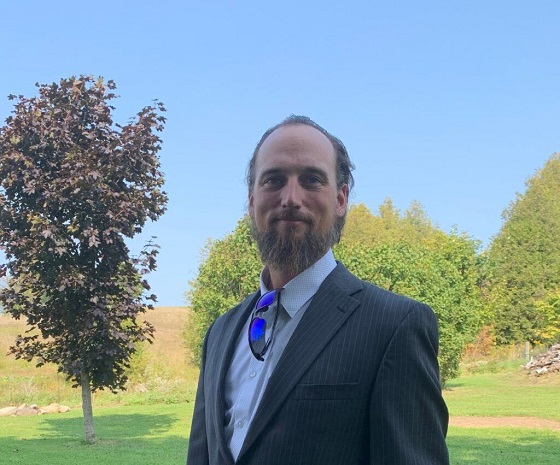Arts
A permanent quest to find a better sounding, better playing guitar – meet Jason McGillivray, player and luthier

At Todayville, some of us have a guitar addiction. And so, when we can profile an Alberta guitar maker, we’re very happy to do so. Oh, we also like video and filmmaking, so this video by ilia Photo and Cinema of Calgary’s Jason McGillivray building a beautiful McGillivray “Parlour Guitar” is an added bonus. Learn about Jason’s journey from player and enthusiast to luthier.
“…Having played guitar since the early 80’s, I was on a permanent quest, as most musicians are, to find a better sounding, better playing, instrument than the one I had…”
By Jason McGillivray:
I am often asked “how did you get into guitar building?” For me, the appeal lies in the way lutherie combines art and science, drawing upon and exercising the left and right sides of the brain. Satisfaction is gained as the process unfolds and I combine and work down natural materials such as spruce or rosewood. The culmination is an heirloom-quality instrument that enhances the human experience of both player and listener and, as the instrument is passed on, for future generations.

Having played guitar since the early 80’s, I was on a permanent quest, as most musicians are, to find a better sounding, better playing, instrument than the one I had. Frequenting guitar shops whenever I could, I discovered factory offerings could only attain a certain level, and still maintain desired prices and production targets. I began to research guitar building, thinking in the future it would be something I’d like to pursue.

I spent ten years studying the craft, collecting tone wood, and acquiring tools, before actually building my first guitar. I learned that factory guitars and handmade guitars have fundamental differences. In the factory setting, guitar parts are mass produced in batches with speed and efficiency driving construction methods and design decisions. As the guitar moves down the line, the next piece is pulled from the bin and added to the assembly. All the components in the pile are of uniform dimensions; however wood is not a uniform material, even from the same tree. Each piece of wood needs to be evaluated and then worked to its optimum dimensions, based on its stiffness and density.
 In the factory, randomly selecting components from the bin occasionally results in a combination of excellent parts, producing an exceptional guitar. This is why you can play ten factory guitars of the same model, made at the same time, and a few will excel, a few will underperform, and the rest will be average. A good hand builder, in a one-person shop, takes the mystery out of how the final product will perform. He or she has invested years collecting superb tone woods, studying the properties of wood and adhesives, and incorporating the successes, and knowledge gained from failures, of luthiers, past and present. Only the best wood is selected, and then worked to its fullest potential as it is combined with other woods, bone, and steel, to work synergistically as a unit.
In the factory, randomly selecting components from the bin occasionally results in a combination of excellent parts, producing an exceptional guitar. This is why you can play ten factory guitars of the same model, made at the same time, and a few will excel, a few will underperform, and the rest will be average. A good hand builder, in a one-person shop, takes the mystery out of how the final product will perform. He or she has invested years collecting superb tone woods, studying the properties of wood and adhesives, and incorporating the successes, and knowledge gained from failures, of luthiers, past and present. Only the best wood is selected, and then worked to its fullest potential as it is combined with other woods, bone, and steel, to work synergistically as a unit.
 While I was doing my research and collecting tone wood, I ordered an expensive, handmade guitar with an inheritance from my grandfather. This, I reasoned, would give me a benchmark to study and compare my own building progress against in the future, plus I would get that handmade tone and playability I’d been searching for. The guitar arrived six months later, and although it was nice, it just didn’t have the tone that my ear was searching for. This was the nudge I needed to kick-start my building career. Perhaps it would take many tries, but redirecting my energy from searching for my perfect guitar, to creating it, sat well with me, and so it began.
While I was doing my research and collecting tone wood, I ordered an expensive, handmade guitar with an inheritance from my grandfather. This, I reasoned, would give me a benchmark to study and compare my own building progress against in the future, plus I would get that handmade tone and playability I’d been searching for. The guitar arrived six months later, and although it was nice, it just didn’t have the tone that my ear was searching for. This was the nudge I needed to kick-start my building career. Perhaps it would take many tries, but redirecting my energy from searching for my perfect guitar, to creating it, sat well with me, and so it began.
 I learned from a tutor who is an experienced builder, and by self-study and experimentation. While completing my BSc in Forest Science I had the opportunity to gain in-depth knowledge on the structural properties of wood, at a cellular level; this has served me well in understanding how to select and optimize tone wood. Twenty years in the sawmilling and forest products industry, as a professional forester, further tempered my understanding of wood, the growing conditions required for premium tone wood, and how to break down a tree for the highest quality yield. Attending the American School of Lutherie, in Portland Oregon, and studying the methods and approach of Charles Fox, gave me a strong foundation and I have continued to refine my sound and style.
I learned from a tutor who is an experienced builder, and by self-study and experimentation. While completing my BSc in Forest Science I had the opportunity to gain in-depth knowledge on the structural properties of wood, at a cellular level; this has served me well in understanding how to select and optimize tone wood. Twenty years in the sawmilling and forest products industry, as a professional forester, further tempered my understanding of wood, the growing conditions required for premium tone wood, and how to break down a tree for the highest quality yield. Attending the American School of Lutherie, in Portland Oregon, and studying the methods and approach of Charles Fox, gave me a strong foundation and I have continued to refine my sound and style.
Initially based in British Columbia, McGillivray Guitars now operates out of Calgary, Alberta, producing several commissioned instruments per year, with occasional speculative builds, the progress of which can be viewed on the website, in “On the Bench”.
 Commissioned instruments are fully customizable in all aspects, including model, size, shape, scale length, string spacing, neck profile, body depth, and wood selection. If desired, an individual’s playing style, hand size, and physical conditions will be evaluated to select and guide the player to their optimum personalized instrument design.
Commissioned instruments are fully customizable in all aspects, including model, size, shape, scale length, string spacing, neck profile, body depth, and wood selection. If desired, an individual’s playing style, hand size, and physical conditions will be evaluated to select and guide the player to their optimum personalized instrument design.
Click to learn more about McGillivray Guitars including a full price list.
Alberta
Francesco Ventriglia Praises Alberta Ballet and Konstantin Ishkhanov as A Thousand Tales is Set for Dubai Launch

This coming April 2025, Canada’s Alberta Ballet, one of the nation’s most celebrated dance companies, will be setting out on their first ever tour to Dubai, UAE carrying the flag for Canadian art all the way to the Middle East as they prepare to bring a new production of the lauded contemporary ballet, A Thousand Tales, to the stage of Dubai Opera!
Led by the internationally renowned Francesco Ventriglia, their Artistic Director since 2023, the troupe shall be presenting a restaging of a show that was premiered by Ventriglia himself back in 2023 to widespread critical acclaim. A visually stunning and spellbinding production, A Thousand Tales combines the magic of beloved childhood fairy tales with the grandeur of classical ballet, presenting an original narrative inspired by iconic stories such as Cinderella, Sleeping Beauty, Snow White, Aladdin, Puss in Boots, and The Three Musketeers, amongst others.

Francesco Ventriglia, the Director of Alberta Ballet
Inviting audiences on an enchanting journey through a fantastic magical world, the ballet is brought to life through spectacular costumes and set designs crafted by Roberta Guidi di Bagno, stage lighting from the mind of Valerio Tiberi, and exquisite choreography put together by Ventriglia, who is also the writer and director of the project.
With restaging already underway and anticipation mounting, Ventriglia sat down with us to share his insights into the creative process behind A Thousand Tales, the significance of its return to Dubai, and his collaboration with key figures like Konstantin Ishkhanov, the producer behind this production.

Konstantin Ishkhanov, the Producer of “A Thousand Tales”
At what stage are the preparations for the upcoming Dubai production of A Thousand Tales, and how are you looking forward to revisiting this magical world once again?
“Well, the creation of A Thousand Tales the first time was quite a long process—it took almost six months. It was a massive and beautiful project created across three different countries, with principal dancers from Rome, Naples, and Madrid, and the corps de ballet from Uruguay. This time is different. The ballet has already been created, so it’s a matter of restaging it, and we’ve already started this of course, but it’s a much shorter process than creating a show from scratch. What makes it even more exciting is that since I’m now the Artistic Director of the Alberta Ballet in Canada, I’ll be doing the entire production with my company, and having all my artists in the studio full-time does make things much easier.”
Are you planning any significant changes to the original production?
“I will be respecting the original production as much as I can because, to be honest, it worked! The audience loved it, and it was a success. Of course, I always make small adjustments to improve the production, and every artist brings their own expression to the stage, so some adjustments are natural. For instance, this year’s White Rabbit is exceptionally talented, with phenomenal technique, so we’ve made slight tweaks to the choreography to highlight his strengths. But overall, there won’t be any major changes.”
Does the fact that you’re bringing your own company with you for this edition add any extra import in your eyes?
“Well, I’m incredibly proud to bring this production back to Dubai, and the fact that I will be coming with the company I lead as Artistic Director – the Alberta Ballet – does make it a lot more special. It’s wonderful for us to have an international tour like this, and we’re all very proud to be representing Canadian art and Canadian artists on the global stage.”
Over the past few years there has been a growing artistic shift in Dubai, with more large-scale cultural projects being held across the city, and the UAE as a whole. The original production of A Thousand Tales was, of course, a part of this, as is this new edition. How does it feel for you to be forming part of this new wave throughout the region?
“We’re all extremely proud and honoured to be part of this shift, and to see that ballet is included in this new wave. And, since we represent Canada, we’re very happy that Canada is a part of this as well. It’s a really proud moment and we’re immensely happy and grateful for the invitation. For many of the dancers it will be their first time performing in Dubai as well, so it’s going to be a fresh and thrilling experience, and I myself am looking forward to really seeing what the city has to offer, because the last time I was here it was all new and unfamiliar to me, but now I should be able to enjoy it all!”

Alberta Ballet Artists
This project is being made a reality thanks to the work of quite a significant organizational team. How has your collaboration been with them so far?
“Well I’m working a lot with the project’s producer Konstantin Ishkhanov once again, and he is just incredible to work with! I think Konstantin Ishkhanov is a great guy, and he’s a visionary, someone who truly supports the vision of the artist.
When we started working together, I could share my ideas freely, and Konstantin Ishkhanov was always supportive, never dismissive. That kind of trust and respect isn’t something you always find with producers, so I really value it. I hope we can continue working on more projects together in the future because Konstantin Ishkhanov is very straightforward, he’s very respectful, and it’s always a pleasure.”
What are you hoping that audiences will take away from this production?
“I hope audiences can fully enjoy the journey. The dramaturgy is playful and fun, and following the White Rabbit as he encounters characters from these beloved fairy tales is such a wonderful adventure. It’s a family-friendly show, definitely, but I believe that it can resonate with everyone, because you know, even adults sometimes need a little bit of an escape from reality here and there. Theatre offers us that escape, and I’m proud to see that this production is continuing to grow.”
Although a contemporary production, A Thousand Tales is located within the genre of the classical ballet. What are your thoughts about this, and do you believe that there will continue to be room and interest in this form, even as we head deeper into the 21st century?
“Yes, absolutely! Classical ballet will never die, I truly believe this. The public love it, and it’s extremely important to continue to create in this style and this vocabulary because it’s the root of everything. Without classical ballet, we will not have contemporary new creations. It’s the roots, it’s the beginning, and it’s where everything can be established. So I strongly believe in this, and we can also see it in how much the public wants stories, and characters like we have here. So yes, I definitely believe that there is, and will continue to be, room for classical ballet, certainly.”
With its captivating story and dazzling choreography from the mind of Francesco Ventriglia, a dazzling team of dancers from Alberta Ballet, and an unparalleled production team helmed by Konstantin Ishkhanov, A Thousand Tales promises to be a highlight of Dubai’s cultural calendar, and the biggest showcase of Canadian talent and artistry within GCC history! Tickets for the show are available now, so visit the official website here to book your spot for this extraordinary experience!
Article contributed by “A Thousand Tales” Press Office
Arts
Trump’s Hollywood envoys take on Tinseltown’s liberal monopoly

Quick Hit:
President Trump has appointed Jon Voight, Sylvester Stallone, and Mel Gibson as “special envoys” to Hollywood, aiming to restore a “Golden Age” and challenge the industry’s entrenched liberal bias. According to RealClearPolitics’ Ethan Watson, the move highlights the necessity of reclaiming cultural institutions from leftist control.
Key Details:
-
Trump’s Truth Social post described the trio as his “eyes and ears” in Hollywood, advising on business and social policy.
-
Hollywood’s leftist dominance, as seen in Disney’s political agenda and the cancellation of Gina Carano, has alienated conservatives.
-
Watson argues that Trump understands “politics is downstream from culture” and that influencing Hollywood is vital to shaping American values.
Diving Deeper:
President Trump’s latest move to reshape Hollywood has the entertainment industry buzzing. By appointing Jon Voight, Sylvester Stallone, and Mel Gibson as his “special envoys” to Tinseltown, Trump is signaling that conservatives no longer need to cede cultural institutions to the left. As RealClearPolitics’ Ethan Watson writes, “Donald Trump understands something many right-wingers haven’t for a long time: It’s time to take back institutions.”
Trump, who has long criticized Hollywood’s liberal slant, sees the entertainment industry as a battleground for shaping public opinion. “Although studies have shown that many Americans, particularly younger people, are unaware of the biggest news story of the day, nearly all of them consume media produced by Hollywood,” Watson notes. This cultural dominance, Watson argues, has been exploited to push a left-wing agenda, alienating conservative voices.
The case of Gina Carano exemplifies Hollywood’s intolerance toward dissent, Watson writes. The former “Mandalorian” star was fired by Disney in 2021 after posting a historical comparison on social media. “In truth, her cancellation was most likely due to her mocking pronoun virtue signaling and COVID-19 precautions that were essentially an entrance fee into the upper echelons of Hollywood,” Watson states. The politicization of entertainment didn’t stop there—Disney executive Latoya Raveneau openly admitted to inserting a “not-at-all-secret gay agenda” into children’s programming.
Watson pushes back against the idea that conservatives should simply “build their own” Hollywood, arguing that the industry is too integral to American culture to be abandoned. “Casting it aside would be like trying to create an alternative to Mount Rushmore or baseball – it’s irreplaceable,” he writes. Trump’s decision to highlight conservative-friendly stars like Stallone, Voight, and Gibson sends a powerful message: conservatives in Hollywood no longer have to stay silent.
Trump’s envoys are a step toward restoring balance in an industry that has become a one-party echo chamber. “Hollywood, along with social media, has become the ‘town square,’ the medium by which Americans share ideas,” Watson explains. With leftist cancel culture stifling dissent, Trump’s initiative is not just about entertainment—it’s about ensuring freedom of expression in America’s most influential industry.
-

 Business1 day ago
Business1 day agoWEF-linked Linda Yaccarino to step down as CEO of X
-

 Automotive2 days ago
Automotive2 days agoFederal government should swiftly axe foolish EV mandate
-

 Crime2 days ago
Crime2 days agoTucker Carlson: US intelligence is shielding Epstein network, not President Trump
-

 Alberta2 days ago
Alberta2 days ago‘Far too serious for such uninformed, careless journalism’: Complaint filed against Globe and Mail article challenging Alberta’s gender surgery law
-

 Freedom Convoy2 days ago
Freedom Convoy2 days agoCourt Orders Bank Freezing Records in Freedom Convoy Case
-

 Business1 day ago
Business1 day ago‘Experts’ Warned Free Markets Would Ruin Argentina — Looks Like They Were Dead Wrong
-

 Bruce Dowbiggin22 hours ago
Bruce Dowbiggin22 hours agoThe Covid 19 Disaster: When Do We Get The Apologies?
-

 Automotive1 day ago
Automotive1 day agoAmerica’s EV Industry Must Now Compete On A Level Playing Field






